Fluoroscopy
9.0 INTRODUCTION
Fluoroscopy is a procedure that provides real-time transient x-ray imaging with permanent recording of appropriate images. Fluoroscopy is not generally intended to generally replace conventional projection radiography. The basic modes of operation of a fluoroscopic system are as follows:
Fluoroscopy using relatively low radiation dose rates provides real-time imaging for positioning with selective recording only when sequences contain sufficient diagnostic information for later use.
Fluorography (acquisition) using substantially higher radiation dose rates provides images for later use with image quality higher than that achievable using stored fluoroscopy.
Fluoroscopic systems are flexible general-purpose devices that are configurable to meet the requirements of a wide range of clinical procedures (Fig. 9-1).
9.1 FLUOROSCOPIC IMAGING CHAIN OVERVIEW
1. Principal feature of fluoroscopy over radiography is the ability to acquire real-time images.
a. Real-time frame rates of 30 frames/s and reduced rates (15, 7.5, 3.75, 2, 1 frames/s).
b. 20-minute fluoro “on-time” at 15 frames/s produces 18,000 individual images.
2. Images (frames) are produced with much less dose than comparable radiograph.
a. Fluoroscopy 10 to 100 nGy/image
b. Fluorography 100 to 1,000 nGy/image—digital acquisition (DA), digital subtraction angiography (DSA)
c. Radiography 3,000 to 10,000 nGy/image
3. Fluoroscopic imaging chain components of a modern system (Fig. 9-2).
a. High gain solid-state flat-panel image detector converts x-ray signal into a series of digital images.
b. Antiscatter grid reduces scatter to achieve good subject contrast.
c. Collimation limits the x-ray beam to the active field of view or to a clinically relevant area.
d. X-ray tube; beam attenuation filters used to reduce dose to patient.
9.2 IMAGING CHAIN COMPONENTS
1. X-ray image intensifier (II)
a. Key component of a fluoroscopy system from approximately 1960 to 2010; many remain in use in 2020
b. Diagram of an II and its components (Fig. 9-3)
c. Input screen
(i) Includes a cesium-iodide (CsI) scintillator that converts the x-ray image into a visible light image and a photocathode that converts the light image into an electron image
(ii) Curved to meet the needs of the II’s electron optics, resulting in pincushion distortion of the image
d. Electron optics
(i) Add energy to the electrons emitted by the photocathode under a potential difference of 20 to 40 kV between the photocathode and the output screen/anode.
(ii) Focus the electrons generated in the active area of the input onto the fixed size output screen.
(iii) Multi-mode IIs have a separate set of electrodes for each input field size.
(iv) Concentrate all of the signal intensity produced at the input screen onto the smaller output screen.
(v) Intensity gain is proportional to the ratios of the areas of the input and output screens (minification).
e. Output screen
(i) Consists of a layer of ZnCdS coated onto either a glass or fiber optic output window.
(ii) Produces an image of fixed diameter irrespective of the size of the active input layer.
(iii) Limiting resolution of an II is inversely proportional to the input screen’s diameter.
f. Optical distributor
(i) Couples the output phosphor image to the video camera with optical lenses or direct fiberoptics.
(ii) Optical aperture adjusts the output light levels for fluoroscopy and fluorography.
(iii) Images are transferred from the output screen via a digital video camera.
(iv) The video image of the output screen is the same size for any FOV setting of the II.
g. Brightness gain = Minification gain × Electronic gain (acceleration of electrons) [9-1]
(i) The input dose level is inversely proportional to the area of the input screen.
(ii) Maintaining the constant light output requires a higher x-ray flux for magnified modes.
h. Conversion factor is the light intensity exiting the II divided by the exposure rate at the input.
(i) A measure of overall performance including brightness gain
(ii) Decreases over time due to degradation of the photocathode
2. Flat-Panel Detectors
a. Replacement for the II tube, optical system, and cameras.
(i) Directly converts x-rays into a digital form.
(ii) Carbon fiber covers reduce x-ray attenuation and increase DQE compared to II.
b. Composed of arrays of detector elements (DEXELS) packaged in a square or rectangular area (Fig. 9-4).
c. Indirect systems have a phosphor layer that absorbs the x-rays and converts a fraction of their energy into light and a photodiode that converts the x-ray-induced light from the phosphor into a corresponding charge.
d. Direct systems have a semiconductor (e.g., selenium) that produces x-ray-induced charge directly, which is captured by the electronics within the same dexel as the x-ray absorption event.
e. FPD readout
(i) For fluoroscopy, after the capacitor is drained, the charge continues to be stored for the next frame.
(ii) Real-time x-ray data are collected as the charge continues to be stored in a steady-state manner.
f. Dexel arrays
(i) Reducing the FOV on spatial resolution differs for an image-intensifier and a FPD (Fig. 9-5).
(ii) In an II, the FOV is reduced by electro-optically focusing a smaller portion of its input screen onto the fixed size output screen, to provide a fixed image size (image-matrix size) for the camera and image processor.
 ▪ FIGURE 9-5 Pixel size and magnification mode—image intensifier and flat-panel detector. A-D. Image intensifier—analog and digital camera outputs. The full pixel array of the digital camera captures the output of the II at any magnification mode. E-G. Flatpanel detector with a fixed dexel array (e.g., Table 9-1 small detector). The same dexel covers the same portion of the patient irrespective of magnification mode (E and F). Resolution does not change when the image is digitally magnified. H. Flat-panel detector with unbundled dexels (e.g., Table 9-1 large detector, small FOV). Resolution is improved if the FPD unbundles dexels when using a small FOV.  F. 9-6 F. 9-6 |
TABLE 9-1 DEXELS, PIXELS, AND FIELD OF VIEW | ||||||||||||||||||||||||||||||||||||||||||||||||||||||||||||||||||||||||||||||||||||
|---|---|---|---|---|---|---|---|---|---|---|---|---|---|---|---|---|---|---|---|---|---|---|---|---|---|---|---|---|---|---|---|---|---|---|---|---|---|---|---|---|---|---|---|---|---|---|---|---|---|---|---|---|---|---|---|---|---|---|---|---|---|---|---|---|---|---|---|---|---|---|---|---|---|---|---|---|---|---|---|---|---|---|---|---|
| ||||||||||||||||||||||||||||||||||||||||||||||||||||||||||||||||||||||||||||||||||||
9.3 FLUOROSCOPIC X-RAY SOURCE ASSEMBLY
1. X-ray tube
a. Have higher heat-storage capacity and faster cooling rates than radiographic tubes.
b. Small focal spot is used for fluoroscopy and large for fluorography (CINE/DA/DSA).
(i) Spatial resolution is likely to decrease when going from fluoroscopy to fluorography.
(ii) Some tubes also have an additional micro-focus focal spot for geometrically magnified procedures.
c. For all modes of operation, newer systems select the smallest focal spot that can accommodate the immediate x-ray power level and may result in spatial resolution differences for thin and thick body parts.
2. Collimator
a. Dynamically adjusts the overall x-ray field size in response to a combination of inputs from both the operator and the system to confine the x-ray beam to the smallest area within the active area of the image receptor consistent with immediate clinical requirements.
b. Wedge filters are used to equalize image receptor inputs when anatomical structures providing very different attenuation (e.g., lung and mediastinum) are simultaneously in the beam.
c. Collimation automatically limits the x-ray beam to the active FOV whenever the FOV is changed and to changes in the source to image-receptor distance (SID).
3. X-ray spectral shaping filters
a. Increases the fraction of x-ray photons in the beam with energies slightly above the K absorption edge material of interest, to improve conspicuity of higher Z elements (e.g., iodine at 33.2 keV).
b. Copper filter (0.1 to 1.0 mm) and restricted x-ray tube voltage (lower kV, e.g., 60) reduce the number of photons in the beam below the iodine edge and limits the number of higher energy photons (Fig. 9-6).
c. Most modern systems have variable thickness copper filters in the collimator assembly.
d. Acquisition selection (e.g., low-dose rate fluoro, standard-dose rate fluoro) and automatic exposure rate control (AERC) can determine filter thickness and beam HVL (see textbook Figure 9-8, page 320 for AERC control of added filtration).
e. Limited x-ray tube power output may require the filter thickness to decrease and the kV to increase.
f. HVL may decrease with an increase in kV if there is a simultaneous decrease in copper thickness.
9.4 CONTROLS
1. Automatic exposure rate control
a. Delivers constant x-ray intensity to the image receptor irrespective of tissue thickness in the beam path.
b. Goal is reasonably constant detector SNR over its working range by maintaining a constant detector entrance dose rate.
c. AERC collects detected x-ray intensity information observed by a predetermined subset of dexels.
(i) Low average signal causes AERC to command the generator to increase x-ray output.
(ii) High average signal causes AERC to decrease x-ray output.
d. AERC output adjustments
(i) Changes in FOV or frame rate adjust x-ray tube output to stabilize perceived image noise.
(ii) X-ray factors (kV, mA, pulse width), focal spot, and beam filtration provide different balances between patient dose and image quality for various system options (Fig. 9-7).
(iii) Image presentation to the operator is further influenced by these changes.
2. Field of view and magnification modes
a. The active FOV of an image intensifier is established by focusing a portion of its input screen onto the full area of the output screen, with an increase in image magnification as the FOV decreases (Fig. 9-5).
b. The active FOV of a flat-panel detector is reduced by accepting information from a smaller area of the image receptor, and the subsequent image is digitally resized to fill the fluoroscope’s display (Fig. 9-5).
c. The brightness gain of an II decreases as the magnification increases—the AERC compensates by boosting the x-ray exposure rate, typically by the square of the input phosphor diameter ratios.
d. Flat-panel systems adjust dose rate when pixels are unbinned, and additional exposure rate increases are applied for all FOVs to meet perceptual requirements, usually linear with changes in active FOV area.
9.5 MODES OF OPERATION
1. Continuous fluoroscopy
a. An uninterrupted x-ray beam with an image stream partitioned into discrete frames by the video system.
b. The typical frame rate is 30 frames per second (FPS).
c. Quantum noise and anatomical motion occurring in a single frame (1/30 s) is averaged and blurred.
d. A second stage of averaging occurs in the observer’s eye due to temporal averaging.
e. A single frame stored and viewed on a display monitor will appear nosier and sharper than the live image because observer temporal averaging no longer influences perception.
2. Pulsed fluoroscopy and fluorography
a. X-ray generator produces a series of short pulses with an on-time smaller than the frame time (Fig. 9-8A).
b. Short pulses (e.g., 3 to 10 ms) reduce blurring of moving objects in individual images.
c. Appearance of a moving object when viewed dynamically is dependent on the interactions of object motion, frame rate, processing of gap-filling display frames, and temporal filtering.
d. An object will often appear sharper when a single image is viewed because there is no temporal averaging in either the image processor or the human visual system.
e. The digital imaging system provides an output frame rate high enough to avoid image flicker by displaying each image multiple times when low acquisition frame rates are used (Fig. 9-8B).
f. Pulsed imaging can reduce radiation because the acquisition frame rate is decoupled from the display rate.
g. Fluorographic images are intended to be viewed individually and therefore requires the same dose per pulse at any frame rate to maintain image SNR.
h. Fluoroscopic images will appear noisier if the same dose per pulse is used for all frame rates.
i. Increasing the fluoroscopy dose per pulse by about 1.4 when the FPS is halved maintains constant noise perception (Fig. 9-8C).
3. Fluorography (unsubtracted)
a. Fluorographic images, also known as digital angiography, DA images, or cine, should only be obtained if the intent is to store them for later review.
b. Enough dose per image is needed to reduce quantum noise to an acceptable value without relying on temporal averaging in the observer’s eye.
c. A single fluorographic frame (not intended for DSA) will require about 10 times the radiation needed for a comparable fluoroscopic frame.
d. Frames intended for DSA will require 50 to 100 times as much radiation as a fluoroscopic frame (Fig. 9-9).
4. Fluorography (subtracted)
a. DSA is performed by acquiring a series of DA images (e.g., 1 to 6 images per second) while a contrast agent (e.g., iodine or CO2) is injected (Fig. 9-10).
b. The first few images contain no contrast agent, and one or an average of images is selected as the mask.
c. The contrast agent moves through the vessels, images contain both anatomy and contrast-enhanced vessels.
d. The mask image is subtracted (pixel by pixel) from the images with contrast images, resulting in the subtraction of the anatomical background.
e. Software tools permit automatic or manual reregistration of images to minimize motion artifacts.
f. DSA removes fixed information common to both the mask and live image.
g. Random noise adds and produces more quantum noise in the difference image than in either initial image.
h. Display contrast is increased to improve visibility of blood vessels or other moving structures. This increases the visibility of quantum noise in the image.
i. Suppressing quantum noise requires the use of more per-image radiation.
j. Nominally, up to 10 times the dose is needed for a single DSA frame than for a comparable unsubtracted fluorographic (DA) image.
k. Using low frame rates, where practicable, reduces radiation.
5. Cine fluorography (analog and digital)
a. The same digital image chain supports fluoroscopy, DSA, and cine. Imaging modes are changed by configuring fluoroscopic hardware and software.
b. Frame rates can be set to conform to procedure specific requirements. Reduction in cine frame rate produces a major reduction in patient dose.
c. Retrospectively stored fluoroscopy (if of adequate quality) can be substituted for acquisitions in the clinical image stream, saving both radiation and the volume of contrast media used in a procedure.
9.6 IMAGE PROCESSING
1. Single image processing
a. This section discusses blurring and unsharp masking applied uniformly across the entire image.
b. Newer algorithms use processing to differentially modify the visibility of objects in different parts of the same image.
c. Image blurring to reduce the visibility of noise (Fig. 9-11).
d. Unsharp masking parameters (Fig. 9-12).
2. Temporal image processing (multi-frame)
a. Individual fluoroscopic images are relatively noisy, with noise patterns statistically changing from frame to frame.
b. Appropriately combining several fluoroscopic frames will improve the perceived SNR while maintaining the system’s inherent spatial resolution at a potential cost of blurring moving objects.
c. Similar processing is seldom needed during fluorography (e.g., cine) because the higher dose per frame is intended to reduce noise.
d. Image processors facilitate task-specific temporal blurring such as recursive filtering (Fig. 9-13).
Stay updated, free articles. Join our Telegram channel

Full access? Get Clinical Tree






















